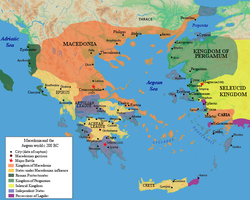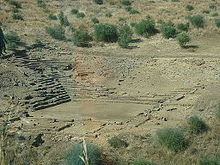This is an old revision of this page, as edited by Furius (talk | contribs) at 20:06, 12 July 2018. The present address (URL) is a permanent link to this revision, which may differ significantly from the current revision.
Revision as of 20:06, 12 July 2018 by Furius (talk | contribs)(diff) ← Previous revision | Latest revision (diff) | Newer revision → (diff)- For the English football league, see Aetolian League (football).


The Aetolian League (also transliterated as Aitolian League) was a confederation of tribal communities and cities in ancient Greece centered in Aetolia in central Greece. It was established, probably during the early Hellenistic era, in opposition to Macedon and the Achaean League. Two annual meetings were held in Thermika and Panaetolika. It occupied Delphi from 290 BC and gained territory steadily until, by the end of the 3rd century BC, it controlled the whole of central Greece outside Attica and Boeotia. At its peak, the league's territory included Locris, Malis, Dolopes, part of Thessaly, Phocis, and Acarnania. In the latter part of its power, certain Greek city-states joined the Aetolian League such as the Arcadian cities of Mantineia, Tegea, Phigalia and Kydonia on Crete.
During the classical period the Aetolians were not highly regarded by other Greeks, who considered them to be semi-barbaric and reckless. Their League had a complex political and administrative structure, and their armies were easily a match for the other Greek powers. However, during the Hellenistic period, they emerged as a dominant state in central Greece and expanded by the voluntarily annexation of several Greek city-states to the League. Still, the Aetolian League had to fight against Macedonia and were driven to an alliance with Rome, which resulted in the final conquest of Greece by the Romans.
Origins
It is uncertain when the League of the Aetolians (Koinon tōn Aitōlōn) was founded. There are suggestions of the year 367 B.C. It has also been suggested that it may have been founded by Epaminondas. Grainger believes that it was founded much later, around the time of the rise of Philip II of Macedon. After Philip's victory of Chaeronea (338 BC), Aetolia was granted Naupaktos, which the Aetolians garrisoned, a level of organization that suggests some formal government rather than the loose alliance of earlier times.
History

During the Peloponnesian War, the Aetolians were initially neutral, but they later fought against the Athenians, who tried to invade Aetolia in 426 BC, but were forced to retreat. The region of Aetolia emerged as one of the most important Greek states after the formation of its League at the second half of the 4th century BC. Its capital city, administrative and religious center was Thermos. In the period following the death of Alexander the Great, the Aetolian League revolted against Antipatros (323 BC) and succeeded in maintaining its independence. As of 290 BC, the League had expanded over its neighboring regions.
In 279 BC, they were victorious in battle against the Gauls, who had invaded Greece and were threatening the sanctuary of Delphi. After their win, they earned the appreciation of the rest of the Greeks and they were admitted as a new member into the Amphictyonic League. In the Social War (220-217 BC), the Aetolian League fought against the Kingdom of Macedonia. Philip V of Macedon invaded Aetolia and sacked the city of Thermos as a response to the Aetolians' invasion at the city of Dodoni in Epirus.
The league was the first Greek ally of the Roman Republic, siding with the Romans during the First Macedonian War (215-205 BC), and helping to defeat Philip V of Macedon at the Battle of Cynoscephalae in 197 BC, during the Second Macedonian War. However, it grew increasingly hostile to Roman involvement in Greek affairs and only a few years later sided with Antiochus III, the anti-Roman king of the Seleucid Empire, during the Roman-Syrian War. The defeat of Antiochus in 189 BC robbed the league of its principal foreign ally and made it impossible to stand alone in continued opposition to Rome. The league was forced to sign a peace treaty with Rome that made it a subject ally of the republic. Although it continued to exist in name, the power of the league was broken by the treaty and it never again constituted a significant political or military force.
Administrative system

According to Scholten, the Aetolian League consisted of elites at the top, but was fundamentally a society of farmers and herders. The league had a federal structure consisting of a federal council in which the level of representation was proportional to the size of a community's contribution to the league's army, a popular assembly of all citizens, which met twice a year in Thermos, and an inner council equivalent to a federal government. It could raise armies and conduct foreign policy on a common basis. It also implemented economic standardization, levying taxes, using a common currency and adopting a uniform system of weights and measures.
Pirate state?
The Aetolian League acquired a reputation for piracy and brigandage. Though there is some recognition that Polybius was, to an extent, following an Achaean bias in his portrayal of the League, many modern historians have accepted this portrayal as in the main justified. For example, Walbank is explicit in seeing the Aetolians as systematically using piracy to supplement their income because of the meager resources of their region and Will simply assumes the truth of the charge.
Grainger devotes a whole chapter to examining Aetolian involvement in piracy along with the charges that the Aetolians were temple robbers. He finds it hard to credit that Aetolia was involved in piracy since they lacked a fleet of even the most basic sort. Further, by contrast with more general historians, those who have made specific studies of piracy and brigandage barely mention Aetolia. He lists the times that the Aetolians were accused of temple robbery and argues that the weight of the accusations should take into account that they are usually made by political opponents of the League and refer to occasions that were already some way in the past when the accusations were made.
References
- Grainger, 1999
- Hogan, 2008
- West, 1902
- http://omiriki-ereuna.blogspot.gr/p/blog-page_2325.html
- N. Tod, A selection of Greek Historical Inscriptions, vol. 2, p. 137
- John D. Grainger, The League of the Aetolians, p. 49
- Istoriai, Thoucydides pages 243-246
- Scholten, 2000
- Walbank , CAH (2) VII 1, 232 and 255
- CAH (2) VII 1, 107
- John D. Grainger, The League of the Aetolians, chap. 2
Sources
- John D. Grainger (1999) The League of the Aitolians (Google Books).
- C. Michael Hogan, Cydonia, Modern Antiquarian, January 23, 2008
- Krzysztof Kęciek (2002) "Kynoskefalaj 197 p.n.e" Serie Historic Battles Published in Warsaw by Bellona.
- Joseph B. Scholten (2000) The Politics of Plunder: Aitolians and Their Koinon in the Early Hellenistic Era (Google Books).
- Willis Mason West (1902) Ancient History to the Death of Charlemagne, Allyn and Bacon.
External links
- [REDACTED] Media related to Aetolian League at Wikimedia Commons